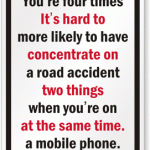The difference between “no parking” and “no stopping”
Some drivers just don’t know when to stop. And who can blame them? All drivers have been directed by “No parking” signs and “No stopping” signs, but how many have stopped, er, paused to consider the difference between these two dictates? At least one California-based Press Enterprise reader has, and, while the answer to the reader’s question may or may not apply in your particular region, the implications to the question are relevant wherever you happen to drive.

The difference between stopping and parking depends on where you are. Image from Nick Fisher.
“‘No parking’ is less restrictive… It means somebody simply can’t park his car where there is such a sign. But he can stop there for 20 seconds or whatever, then move on. Or maybe the difference isn’t so obvious? Do the traffic laws on this get real technical?” inquired the reader. Columnist Rick Davis investigated, finding that, according to California Vehicle Code, there is a difference between stopping and parking your car.
Stopping, in California, is defined as “any cessation of movement of a vehicle, whether occupied or not — except when necessary to avoid conflict with other traffic or when in compliance with the direction of a police officer or official traffic control device or signal.” Parking, on the other hand, is “the standing of a vehicle, whether occupied or not — and other than temporarily — for the purpose of, and while actually engaged in, loading or unloading of merchandise or passengers.”
While the law doesn’t define “temporarily,” it does imply that a vehicle is parked only if it’s there permanently (though, as Davis points out, “permanently” isn’t used in the law either). The law would suggest that if a certain area of the road is “designated and posted… as a ‘no stopping’ zone,” vehicles traveling on that road can’t stop completely within that area, no matter how short the potential pit stop is.
The rules are perhaps the clearest in New York State, where the DMV clearly defines stopping, standing, and parking. “A ‘No parking’ sign means you can make a temporary stop to load or discharge merchandise or passengers. A ‘No standing’ sign means you can make a temporary stop to load or discharge passengers. A ‘No stopping’ sign means you can stop only to obey a traffic sign, signal or officer or to prevent conflicts with other vehicles.” You can learn more about New York’s guidelines here.
Pennsylvania parking rules are a bit more opaque. State code says that “Stopping, standing or parking may be restricted along the curb or edge of a roadway [is illegal] when one or more of the following conditions exist,” with nine different conditions listed. Florida has comparable guidelines, expressly forbidding what many drivers would consider a brief stop: standing or parking “except momentarily to pick up or discharge a passenger or passengers” under conditions like in front of a driveway, within 15 feet of a fire hydrant or 20 feet of a crosswalk at an intersection, within 30 feet upon the approach to any flashing signal, stop sign, or traffic control signal located at the side of a roadway, and a number of other conditions.
Texas’s guidelines and Illinois’s guidelines are similar to both Pennsylvania and Florida’s. Tired of Parking Tickets, Inc. makes the unclear guidelines a bit easier to understand for Chicagoans in particular. For one, “‘No parking’ means that you can’t park your car and walk away, but you can stand in your car… You can wait as long as you like while standing as long as you’re not asked to move by a police officer or traffic enforcement agent (you must move if asked).” As for the difference between “No stopping” and “No parking,” the site explains, “No stopping means exactly what it says—you can’t stop there at all, not even for one second!”
Consult your state’s DMV for more details on deciphering these signs in your neck of the woods.
Related Posts
Category: Regulations

















